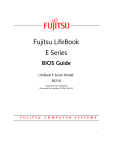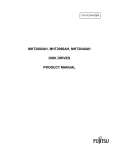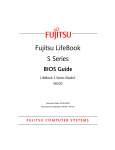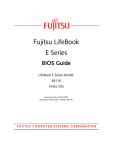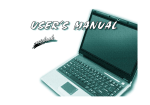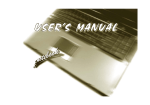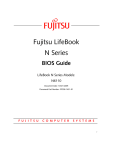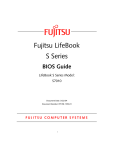Download Fujitsu N6000 User's Manual
Transcript
Fujitsu LifeBook N Series BIOS Guide LifeBook N Series Models: N6000 Document Date: 11/11/04 Document Part Number: FPC58-1268-01 F U J I T S U C O M P U T E R S Y S T E M S 1 LifeBook N Series Notebook BIOS N Series BIOS ■ Selecting a field causes a help message about that field to be displayed on the right-hand side of the screen. ■ Pressing the Enter key with the highlight on a selection that is not a submenu or auto selection will cause a list of all options for that item to be displayed. Pressing the Enter key again will select the highlighted choice. BIOS SETUP UTILITY The BIOS Setup Utility is a program that sets up the operating environment for your notebook. Your BIOS is set at the factory for normal operating conditions, therefore there is no need to set or change the BIOS environment to operate your notebook. The BIOS Setup Utility configures: ■ ■ Device control feature parameters, such as changing I/O addresses and boot devices. System Data Security feature parameters, such as passwords. Entering the BIOS Setup Utility To enter the BIOS Setup Utility do the following: 1. Turn on or restart your notebook. 2. Press the [F2] key once the Fujitsu logo appears on the screen. This will open the main menu of the BIOS Setup Utility with the current settings displayed. 3. Press the arrow keys to scroll through the other setup menus to review or alter the current settings. Navigating Through The Setup Utility The BIOS setup utility consists of six menus: Main, Advanced, Security, Boot, Info, and Exit. This document explains each menu in turn, including all submenus and setup items. The following procedures allow you to navigate the setup utility menus: ], [ ]. 1. To select a menu, use the cursor keys: [ 2. To select a field within a menu or a submenu, use the 7. Pressing the [F9] key resets all items in the BIOS to the default values. 8. Pressing the [F10] key saves the current configuration and exits the BIOS Setup Utility. You will be asked to verify this selection before it is executed. 9. Pressing the [F1] key gives you a general help screen. Entering the Setup Utility After a Configuration Change or System Failure If there has been a change in the system configuration that does not agree with the parameter settings stored in your BIOS memory, or there is a failure in the system, the system beeps and/or displays an error message after the Power On Self Test (POST). If the failure is not too severe, it will give you the opportunity to modify the settings of the setup utility, as described in the following steps: 1. When you turn on or restart the computer there is a beep and/or the following message appears on the screen: Error message - please run SETUP program Press <F1> key to continue, <F2> to run SETUP 2. If an error message is displayed on the screen, and you want to continue with the boot process and start the operating system anyway, press the [F1] key. cursor keys: [ ], [ ]. 3. To select the different values for each field, press the [Spacebar] or [+] to change to the next higher selection and [F5] or [-] to go to the next lower selection. 4. To activate a submenu press the [Enter] key. 5. To return to a menu from a submenu, press the [Esc] key. 6. To go to the Exit menu from any other menu, press the [Esc] key. 2 ■ If your notebook emits a series of beeps that sounds like a code and the display is blank, refer to the Troubleshooting section of your system Use’s Guide. The Troubleshooting Section includes a list of error messages and their meanings. ■ If your data security settings require it, you may be asked for a password before the operating system will be opened. BIOS Setup Utility 3. If an error message is displayed on the screen, and you want to enter the setup utility, press the [F2] key. 4. When the setup utility starts with a fault present, the system displays the following message: Warning! Error message [Continue] 5. Press any key to enter the setup utility. The system will then display the Main Menu with current parameters values. 3 LifeBook N Series Notebook BIOS MAIN MENU – SETTING STANDARD SYSTEM PARAMETERS The Main Menu allows you to set or view the current system parameters. Follow the instructions for Navigating Through The Setup Utility to make any changes. (See Navigating Through The Setup Utility on page 2 for more information.) the field’s function and any special information needed to help understand the field’s use. System Time and System Date can also be set from your operating system without using the setup utility. Use the calendar and time icon on your Windows Control panel or type time or date from the MSDOS prompt. The following tables show the names of the menu fields for the Main menu and its submenus, all of the options for each field, the default settings and a description of Main Advanced PhoenixBIOS Setup Utility Security Boot Info Exit Item Specific Help System Time: System Date: [14:57:01] [11/11/2004] Adjust calendar clock. ▲ ▲ Primary Master Secondary Master [FUJITSU MHT2060H-(PM)] [DV-W28E-(SM)] Language: [English (US)] Select Item Select Menu -/Space Change Values Enter Select Sub-Menu ▲ F1 Help ESC Exit <Tab>, <Shift-Tab>, or <Enter> selects field. F9 F10 Setup Defaults Save and Exit Figure 1. Main Menu Table 1: Fields, Options and Defaults for the Main Menu Note that the parameters listed in the following table may vary depending upon your system’s configuration. Menu Field Options Default Description System Time: –— –— Sets and displays the current time. Time is in a 24 hour format of hours:minutes:seconds with 2 digits for each. (HH:MM:SS). Example: 16:45:57. You may change each segment of the time separately. Move between the segments with the [Tab] key and/ or [Shift] + [Tab] keys. System Date: –— –— Sets and displays the current date. Date is in a month/day/year numeric format with 2 digits each for month and day and 4 digits for year. (MM/DD/YYYY) for example: 03/20/1998. You may change each segment of the date separately. Move between the segments with the [Tab] key and/or [Shift] + [Tab] keys. 4 Main Menu Table 1: Fields, Options and Defaults for the Main Menu Note that the parameters listed in the following table may vary depending upon your system’s configuration. Menu Field Options Default Description Primary Master: Selects Primary Master submenu The product number of the hard drive. Display the type of device on this ATA/ATAPI interface, if there is one. Pressing the Enter key selects the Primary Master submenu allowing additional device configuration options for this interface. Secondary Master Selects Secondary Master submenu The product number of the CD-ROM drive. Display the type of device on this ATA/ATAPI interface, if there is one. Pressing the Enter key selects the Secondary Master submenu allowing additional device configuration options for this interface Language: ■ [English (US)] The default setting differs between the US/European and the Japanese model. Selects the display language for the BIOS. (Note that this field may appear blank until the first time it is selected.) ■ English (US) Japanese (JP) 5 LifeBook N Series Notebook BIOS Primary Master Submenu of the Main Menu The Primary Master submenu identifies what ATA devices are installed. PhoenixBIOS Setup Utility Main Primary Master [FUJITSU MHT2060AH-(PM)] Type: Item Specific Help Select ATA/ATAPI drive installed here. Total Sectors: Maximum Capacity: [Auto]] LBA Format 117210240 60012MB Multi-Sector Transfers: LBA Mode Control: Transfer Mode: Ultra DMA Mode: [16 Sectors] [Enabled] [FPIO 4 / DMA 2] [Disabled] [Auto] The BIOS auto-types the drive on boot time. Except [Auto] You enter parameters of the drive. [None] The drive is disabled. Select Item Select Menu -/Space Change Values Enter Select Sub-Menu ▲ F1 Help ESC Exit F9 Setup Defaults F10 Save and Exit Figure 2. Primary Master Submenu Table 2: Fields, Options and Defaults for the Primary Master Submenu of the Main Menu Menu Field Options Default Description Type: ■ [Auto] Selects the ATA/ATAPI device type. To change the selection, press the spacebar. Select Auto to have the type automatically identified by the BIOS at POST. If None is selected, all of the following Set-up items do not appear. Select CD-ROM if a CD-ROM drive is installed at this connection. If Hard Disk is selected, you must specify the number of Cylinders, Heads, and Sectors for the drive. ■ ■ ■ Auto None CD-ROM Hard Disk LBA Format Logical Block Addressing (LBA) Total Sectors: --- --- The total number of sectors on your hard disk Maximum Capacity: --- --- The maximum capacity of your hard disk CHS Format Cylinders: 6 Cylinders/Heads/Sectors ■ A number between 0 and 65,535 –— This item is active only when Hard Disk is selected as the type. This field is changed by incrementing (pressing the [Spacebar]) or by typing in the number. Main Menu Table 2: Fields, Options and Defaults for the Primary Master Submenu of the Main Menu Menu Field Options Default Description Heads: ■ A number between 1 and 16 –— This item is active only when Hard Disk is selected as type. You can change the value by incrementing (pressing the [Spacebar]) or by typing in the number. Sectors: ■ A number between 0 and 63 –— This item is active only when Hard Disk is selected as type. You can change the value by incrementing (pressing the [Spacebar]) or by typing in the number. Maximum Capacity: ■ Display only –— Displays the maximum capacity of the drive calculated from the parameters of the hard disk when Auto is selected and the type is identified as hard disk. ■ Disabled 2 Sectors 4 Sectors 8 Sectors 16 Sectors [16 Sectors] This option cannot be changed when Auto is selected. Specify the number of sectors per block for multiple sector transfer. Disabled Enabled [Enabled] Enables or disables logical Block Addressing in place of Cylinder, Head, Sector addressing. This option cannot be changed when Auto is selected. Standard Fast PIO 1 Fast PIO 2 Fast PIO 3 Fast PIO 4 FPIO 3 / DMA 1 FPIO 4 / DMA 2 [FPIO 4 / DMA 2] Selects the method for moving data to/from the drive. Autotype the drive to select the optimum transfer mode. This option cannot be changed when Auto is selected. Disabled Mode 0 Mode 1 Mode 2 Mode 3 Mode 4 Mode 5 [Disabled] Selects the method for moving data to/from the drive. Autotype the drive to select the optimum transfer mode. This option cannot be changed when Auto is selected. LBA and CHS Multi-Sector Transfers: ■ ■ ■ ■ LBA Mode Control: ■ ■ Transfer Mode: ■ ■ ■ ■ ■ ■ ■ Ultra DMA Mode: ■ ■ ■ ■ ■ ■ ■ 7 LifeBook N Series Notebook BIOS Secondary Master Submenu of the Main Menu The Secondary Master submenu allows you to configure secondary ATA devices. PhoenixBIOS Setup Utility Main Secondary Master [TOSHIBA DVD-ROM SD-R2412] Type: [Auto] Multi-Sector Transfers: LBA Mode Control: Transfer Mode: Ultra DMA Mode: [Disabled] [Disabled] [Standard] [Disabled] Item Specific Help Select ATA/ATAPI drive installed here. [Auto] The BIOS auto-types the drive on boot time. Except [Auto] You enter parameters of the drive. [None] The drive is disabled. Select Item Select Menu -/Space Change Values Enter Select Sub-Menu ▲ F1 Help ESC Exit F9 Setup Defaults F10 Save and Exit Figure 3. Secondary Master Submenu Table 3: Fields, Options and Defaults for the Secondary Master Submenu of the Main Menu Menu Field Options Default Description Type: ■ [Auto] NOTE: The Type field does not appear as a drop-down menu. Tap the spacebar to cycle through the selections. ■ ■ ■ Auto None CD-ROM Hard Disk Selects the ATA/ATAPI device type. Select Auto to have the type automatically identified by the BIOS at POST. If None is selected, all of the following Set-up items do not appear. Select CD-ROM, SuperDisk or Hard Disk for appropriate drive type installed at this connection. CHS Format 8 Cylinders/Heads/Sectors Cylinders: ■ A number between 0 and 65,535 –— This item appears only when Hard Disk is selected as the type. This field is changed by incrementing (pressing the [Spacebar]) or by typing in the number. Heads: ■ A number between 1 and 16 –— This item appears only when Hard Disk is selected as type. You can change the value by incrementing (pressing the [Spacebar]) or by typing in the number. Sectors: ■ A number between 0 and 63 –— This item appears only when Hard Disk is selected as type. You can change the value by incrementing (pressing the [Spacebar]) or by typing in the number. Main Menu Table 3: Fields, Options and Defaults for the Secondary Master Submenu of the Main Menu Menu Field Options Default Description Maximum Capacity: ■ Display only –— Displays the maximum capacity of the drive calculated from the parameters of the hard disk when Auto is selected and the type is identified as hard disk, or User is selected. Multi-Sector Transfers: ■ Disabled 2 Sectors 4 Sectors 8 Sectors 16 Sectors [Disabled] This option cannot be changed when Auto is selected. Specify the number of sectors per block for multiple sector transfer. Disabled Enabled [Disabled] Enables or disables Logical Block Addressing in place of Cylinder, Head, Sector addressing. This option cannot be changed when Auto is selected. Standard Fast PIO 1 Fast PIO 2 Fast PIO 3 Fast PIO 4 FPIO 3 / DMA 1 FPIO 4 / DMA 2 [Standard] Selects the method for moving data to/from the drive. Autotype the drive to select the optimum transfer mode. This option cannot be changed when Auto is selected. Multi-word DMA is automatically set to mode 1 for Fast PIO 1, Fast PIO 2, Fast PIO 3, and set to mode 2 for Fast PIO 4 / DMA. Disabled Mode 0 Mode 1 Mode 2 Mode 3 Mode 4 Mode 5 [Disabled] Selects the method for moving data to/from the drive. Autotype the drive to select the optimum transfer mode. This option cannot be changed when Auto is selected. ■ ■ ■ ■ LBA Mode Control: ■ Transfer Mode: ■ ■ ■ ■ ■ ■ ■ ■ Ultra DMA Mode: ■ ■ ■ ■ ■ ■ ■ LBA Format Logical Block Addressing (LBA) Total Sectors: --- --- The total number of sectors on your hard disk Maximum Capacity: --- --- The maximum capacity of your hard disk Exiting from Main Menu When you have finished setting the parameters on this menu, you can either exit from the setup utility, or move to another menu. If you wish to exit from the setup utility, press the [Esc] key or use the cursor keys to go to the Exit menu. If you wish to move to another menu, use the cursor keys. 9 LifeBook N Series Notebook BIOS ADVANCED MENU – SETTING DEVICE FEATURE CONTROLS The Advanced Menu allows you to: ■ ■ ■ ■ ■ ■ Set the I/O addresses for the serial and parallel ports. Set the keyboard and mouse features. Select between the display panel and an external CRT display. Enable or disable compensation for your display. Enables or disables the internal controllers. Configure CPU and USB features in your system. Main Advanced Follow the instructions for Navigating Through the Setup Utility to make any changes. (See Navigating Through The Setup Utility on page 2 for more information.) The following tables show the names of the menu fields for the Advanced Menu and its submenus, all of the options for each field, the default settings and a description of the field’s function and any special information needed to help understand the field’s use. PhoenixBIOS Setup Utility Security Boot Info Exit Item Specific Help ▲ ▲ ▲ ▲ ▲ ▲ Keyboard Features Video Features Internal Device Configurations CPU Features USB Features Miscellaneous Configurations ▲ Event Logging Select Item Select Menu -/Space Change Values Enter Select Sub-Menu ▲ F1 Help ESC Exit Configures keyboard/ mouse features. F9 Setup Defaults F10 Save and Exit Figure 4. Advanced Menu Table 4: Fields, Options and Defaults for the Advanced Menu Menu Field Description Keyboard Features When selected, opens the Keyboard Features submenu, which allows turning NumLock on and off. Video Features When selected, opens the Video Features submenu, which allows setting of the display parameters, including routing of video signals to different displays. Internal Device Configurations When selected, opens the Internal Device Configuration submenu, which allows enabling or disabling the IDE, Modem, LAN, and WLAN Controllers. CPU Features When selected, opens the CPU Features submenu to allow you to enable or disable the HT (Hyper-Threading) Technology feature and HT Power Management. 10 Advanced Menu Table 4: Fields, Options and Defaults for the Advanced Menu Menu Field Description USB Features When selected, opens the USB Features submenu to allow you to enable or disable the legacy support and SCSI SubClass support (e.g., floppy disk drive, external optical drive). Miscellaneous Configurations When selected, opens the Miscellaneous Configurations submenu to allow you to enable or disable the power button, the Wake Up On LAN feature, system beep, and Instant MyMedia.. Event Logging When selected, opens the event logging submenu. 11 LifeBook N Series Notebook BIOS Keyboard Features Submenu of the Advanced Menu The Keyboard Features submenu is for enabling or disabling the NumLock feature. Main Advanced PhoenixBIOS Setup Utility Security Power Savings Exit Item Specific Help Keyboard Features Numlock: Select Item Select Menu -/Space Change Values Enter Select Sub-Menu ▲ F1 Help ESC Exit Select power-on state for Numlock. [On] F9 Setup Defaults F10 Save and Exit Figure 5. Keyboard Features Submenu Table 5: Fields, Options and Defaults for the Keyboard Submenu of the Advanced Menu Menu Field Options Default Description Numlock: ■ [On] Sets the NumLock function state when the computer completes booting. ■ 12 On Off Advanced Menu Video Features Submenu of the Advanced Menu The Video Features Submenu is for setting the display parameters. Main Advanced PhoenixBIOS Setup Utility Security Power Savings Exit Item Specific Help Video Features Display: Compensation: [Auto] [Enabled] Select display terminal. * This setting is not effective after operating system starts up. Select Item Select Menu -/Space Change Values Enter Select Sub-Menu ▲ F1 Help ESC Exit F9 Setup Defaults F10 Save and Exit Figure 6. Video Features Submenu Table 6: Fields, Options and Defaults for the Video Features Submenu of the Advanced Menu Menu Field Options Default Description Display: ■ Internal Flat Panel External Auto [Auto] Selects where the video signal will be routed. Disabled Enabled [Enabled] Enables or disables compensation which controls spacing on the display. When enabled, displays with less than pixel resolution 1024 x 768 or 800 x 600 will still cover the entire screen. A resolution below 800 x 600 will fill the screen, but due to the low resolution, will appear blocky and may not be acceptable. ■ ■ Compensation: ■ ■ 13 LifeBook N Series Notebook BIOS Internal Device Configurations Submenu of the Advanced Menu The Internal Device Configuration submenu allows the user to configure other internal devices. Main Advanced PhoenixBIOS Setup Utility Security Power Savings Exit Item Specific Help Internal Devices Configurations IDE Controller: Modem Controller: LAN Controller: Wireless LAN: [Disabled] No IDE ports are enabled. [Both] [Enabled] [Enabled] [Enabled] [Primary] Only primary IDE port is enabled. [Secondary] Only secondary IDE port is enabled. [Both] Both primary and secondary IDE ports are enabled. Select Item Select Menu -/Space Change Values Enter Select Sub-Menu ▲ F1 Help ESC Exit F9 Setup Defaults F10 Save and Exit Figure 7. Internal Device Configuration Submenu Table 7: Fields, Options and Defaults for the Internal Device Configuration Submenu of the Advanced Menu Menu Field Options Default Description IDE Controller: ■ Disabled Primary Secondary Both [Both] Enables or disables selected IDE devices. Disabled Enabled [Enabled] Enables or disables Modem controller. Disabled Enabled [Enabled] Enables or disables the LAN controller. Disabled Enabled [Enabled] Enables or disables the wireless LAN. ■ ■ ■ Modem Controller: ■ ■ LAN Controller: ■ ■ Wireless LAN: ■ ■ 14 Advanced Menu CPU Features Submenu of the Advanced Menu The CPU Features Submenu provides options for enabling or disabling the Hyper-Threading (HT) Technology feature. Main Advanced PhoenixBIOS Setup Utility Security Power Savings Exit CPU Features Item Specific Help Select HT Technology enabled or disabled. [Enabled] HT Technology: Power Management: [Enabled] Select Item Select Menu -/Space Change Values Enter Select Sub-Menu ▲ F1 Help ESC Exit F9 Setup Defaults F10 Save and Exit Figure 8. CPU Features Submenu Table 8: Fields, Options and Defaults for the CPU Features Submenu of the Advanced Menu Menu Field Options Default Description HT Technology: ■ Disabled Enabled [Enabled] When Enabled is selected, Hyper-Threading technology is enabled. When Disabled is selected, Hyper-Threading technology is disabled. Disabled Enabled [Enabled] When Enabled is selected, Hyper-Threading technology power management capabilities are enabled. When Disabled is selected, Hyper-Threading technology power management capabilities are disabled. ■ Power Management: ■ ■ 15 LifeBook N Series Notebook BIOS USB Features Submenu of the Advanced Menu The USB Features Submenu provides options for enabling or disabling the USB Floppy Disk Drive. Main Advanced PhoenixBIOS Setup Utility Security Power Savings Exit USB Features Legacy USB Support: SCSI SubClass Support: Item Specific Help [Disabled] The feature is disabled. [Enabled] [Enabled] [Enabled] Legacy USB Emulation is enabled and USB devices are available without USB aware OS. Select Item Select Menu -/Space Change Values Enter Select Sub-Menu ▲ F1 Help ESC Exit F9 Setup Defaults F10 Save and Exit Figure 9. USB Features Submenu Table 9: Fields, Options and Defaults for the USB Features Submenu of the Advanced Menu Menu Field Options Legacy USB Support: ■ ■ SCSI SubClass Support: 16 ■ ■ Default Description Disabled Enabled [Enabled] When Enabled is selected, Legacy USB Emulation is enabled and the USB devices are available without a USB-aware OS. When Disabled is selected, Legacy USB support is disabled. Disabled Enabled [Enabled] When Enabled is selected, USB devices that belong to the SCSI subclass in the mass storage class (e.g., USB Memory Key) are enabled. Note that enabling this feature may cause the system to hang during POST, depending on the device that is connected. Advanced Menu Miscellaneous Configurations Submenu of the Advanced Menu The Miscellaneous Configurations Submenu provides options for enabling or disabling the power button and the Wake Up On LAN feature, and for enabling or disabling the system beep. Main Advanced PhoenixBIOS Setup Utility Security Power Savings Exit Miscellaneous Configurations Power Button: Wake up on LAN: System Beep: Instant MyMedia: Select Item Select Menu Configures the power button. [Disabled] [Disabled] [Enabled] [Enabled] *ACPI OS ignores this setting. -/Space Change Values Enter Select Sub-Menu ▲ F1 Help ESC Exit Item Specific Help F9 Setup Defaults F10 Save and Exit Figure 10. Miscellaneous Configurations Submenu Table 10: Fields, Options and Defaults for the Miscellaneous Configurations Submenu of the Advanced Menu Menu Field Options Default Description Power Button: ■ Disabled Power Off [Disabled] Selecting Disabled disables the power button. Selecting Power Off allows you to turn off system power with the power button. Disabled Enabled [Disabled] Selecting Enabled allows the system to wake up when the internal LAN device receives a specific signal while in power-off state. Selecting Disabled disables this feature. Disabled Enabled [Enabled] Allows you to enable and disable the system beep. Disabled Enabled [Enabled] Allows you to enable and disable the Instant MyMedia utility. ■ Wake up on LAN: ■ ■ System Beep: ■ ■ Instant MyMedia: ■ ■ 17 LifeBook N Series Notebook BIOS Event Logging Submenu of the Advanced Menu The Event Logging Submenu configures event logging features for DMI events. Main PhoenixBIOS Setup Utility Security Power Savings Exit Advanced Item Specific Help Event Logging Event Log Capacity: Event Log Validity: Space Available Valid View Event Log: [Enter] Event Logging: System Boot Event: [Enabled] [Disabled] Clear All Event Logs: [No] Mark Events as Read: [Enter] Select Item Select Menu -/Space Change Values Enter Select Sub-Menu ▲ F1 Help ESC Exit Press <Enter> key to view the contents of the event log. F9 Setup Defaults F10 Save and Exit Figure 11. Event Logging Submenu Table 11: Fields, Options and Defaults for the Event Logging Submenu of the Advanced Menu Menu Field Options Default Description Event Log Capacity: Space Available Display only Event Log Validity: Valid Display only View Event Log: ■ Enter [Enter] Allows you to view content of event log Event Logging: ■ Disabled Enabled [Enabled] Turns event logging on and off for all DMI events. Disabled Enabled [Disabled] Turns event logging on and off for DMI system boot events. No Yes [No] When set to [Yes] all event logs will be cleared at next boot. Enter [Enter] Allows you to mark all events currently in the event log as having been read. ■ System Boot Event: ■ ■ Clear All Event Logs: ■ Mark Events as Read: ■ 18 ■ Security Menu SECURITY MENU – SETTING THE SECURITY FEATURES The Security menu allows you to set up the data security features of your notebook to fit your operating needs and to view the current security configuration. Follow the instructions for Navigating Through the Setup Utility to make any changes. (See Navigating Through The Setup Utility on page 2 for more information.) The following tables show the names of the menu fields for the Security menu and its submenus, all of the options for each field, the default settings and a description of the field's function and any special information needed to help understand the field's use. The default condition is no passwords required and no write protection. ■ Entering a password incorrectly 3 times in a row will cause the keyboard and mouse to be locked out and the warning [System Disabled] to be displayed. If this happens restart the computer by turning off and on the power with the power switch and use the correct password on reboot. ■ If you make an error when re-entering the password a [Warning] will be displayed on the screen. To try again press the Enter key and then retype the password. Press the Esc key to abort the password setting process. ■ If the Power Management Security is Enabled and the Password on Boot is Disabled you will not have to type your password upon resuming the system from the Suspend or Save-to-Disk modes. Power Management Security will work only if Password boot is enabled. If you set a password, write it down and keep it in a safe place. If you forget the password you will have to contact your support representative to regain access to your secured functions and data. Main Advanced PhoenixBIOS Setup Utility Security Boot Info Exit Item Specific Help Supervisor Password Is: User Password Is: Clear Clear Set Supervisor Password Set User Password Minimum User Password Length: [Enter] [Enter] [0] Password on boot: On Automatic Wake up: KB Lock on Resume: Boot from Removable Media: Flash Write: [Disabled] [Disabled] [Disabled] [All] [Enabled] Press <Enter> key to set Supervisor Password to enable any password features. Then password entry is required to enter BIOS Setup. ▲ ▲ Hard Disk Security Owner Information Select Item Select Menu -/Space Change Values Enter Select Sub-Menu ▲ F1 Help ESC Exit F9 Setup Defaults F10 Save and Exit Figure 12. Security Menu 19 LifeBook N Series Notebook BIOS Table 12: Fields, Options and Defaults for the Security Menu Menu Field Options Default Description Supervisor Password is: –— Clear A display-only field. Set is displayed when the system supervisor password is set and Clear when it is not. User Password is: –— Clear A display-only field. Set is displayed when the general user password is set, and Clear when it is not. Set Supervisor Password –— [Enter] Sets, changes or cancels the Supervisor Password. Supervisor’s Password may be up to seven characters long and must include only letters or numbers (no symbols). Passwords are NOT case- sensitive. To cancel a password press the Enter key instead of entering characters in the Enter New Password field and in the Re-enter New Password field. When a Supervisor Password is set it must be used to access the BIOS setup utility. Set User Password –— [Enter] This field can only be accessed if the Supervisor Password is set. Sets, changes or cancels the User Password. The User Password may be up to seven characters long and must include only letters or numbers (no symbols). Passwords are NOT case-sensitive. To cancel a password press the Enter key instead of entering characters in the Enter New Password field and in the Re-enter New Password field. When a User Password is set it must be used to access the BIOS setup utility. Minimum User Password Length: –— [0] Supervisor can set password length (0 to 8) for user password. User cannot set a password shorter than the minimum length. Password on Boot: ■ Disabled First Boot Every Boot [Disabled] When set to First Boot, a password (User or Supervisor) is required just once after the Power On Self Test (POST) before the operating system will be read from a disk. When set to Every Boot, a password (User or Supervisor) is required every time after the Power On Self Test (POST) before the operating system will be read from a disk. When set to Disabled no password is required. Disabled Enabled [Disabled] When set to Disabled, it is not necessary to enter a password to wake up from LAN or Real Time Clock (RTC). When Enabled, it is still necessary to enter a password after automatic wake-up. Disabled Enabled [Disabled] When set to Enabled, the PS/2 mouse and keyboard inputs are locked out upon Resume from Suspend or Save to Disk mode until you enter the password. When set to Disabled no password is required. If no Supervisor Password is set, this feature is not available and no password is required. All Supervisor only [All] When All is selected, booting from removable media is not restricted. When Supervisor Only is selected, only the Supervisor (i.e., the user who enters Supervisor password), can boot from removable media. Disabled Enabled [Enabled] When set to [Disabled], the BIOS Flash memory is write protected. ■ ■ On Automatic Wake up: ■ KB Lock on Resume: ■ Boot from Removable Media: ■ Flash Write: ■ ■ ■ ■ ■ Hard Disk Security: –— –— Configures hard disk security features Owner Information: –— –— Sets Owner information. Exiting from the Security Menu When you have finished setting the parameters on the Security Menu, you can either exit from setup utility or move to another menu. If you wish to exit from setup utility, press the Esc key to go to the Exit Menu. If you wish to move to another menu, use the cursor keys. 20 Security Menu Hard Disk Security Submenu of the Security Menu The Hard Disk Security Submenu is for configuring hard disk security features. Main Advanced PhoenixBIOS Setup Utility Security Power Savings Exit Hard Disk Security Primary Master Password Is: Clear Set Primary Master Password: [Enter] Password Entry on Boot: [Enabled] Select Item Select Menu -/Space Change Values Enter Select Sub-Menu ▲ F1 Help ESC Exit Item Specific Help F9 Setup Defaults F10 Save and Exit Figure 13. Hard Disk Security Submenu Table 13: Fields, Options and Defaults for the Hard Disk Security Submenu of the Security Menu Menu Field Options Default Description Primary Master Password Is: --- Clear The default is Clear. When the Master Password has been set in the field below, the field changes to Set. Set Primary Master Password: --- [Enter] When the Supervisor Password has been set, the field can be changed. When enabled, the hard disk is locked with the password. Data in the locked disk cannot be read on any systems other than the original system on which it is locked or systems that have the identical password setting. Password Entry on Boot: ■ [Enabled] When disabled, the master password entry is not required before booting the operating system, but the hard disk is still password-protected without password entry. ■ Disabled Enabled 21 LifeBook N Series Notebook BIOS Owner Information Submenu of the Security Menu The Owner Information Submenu is for setting owner information. Note that the owner information cannot be set without having entered a Supervisor password. Main Advanced PhoenixBIOS Setup Utility Security Power Savings Exit Owner Information Owner Information Is: Clear Set Owner Information [Enter] Foreground Color: Background Color: [Gray] [Black] Select Item Select Menu -/Space Change Values Enter Select Sub-Menu ▲ F1 Help ESC Exit Item Specific Help F9 Setup Defaults F10 Save and Exit Figure 14. Owner Information Submenu Table 14: Fields, Options and Defaults for the Owner Information Submenu of the Security Menu Menu Field Options Default Description Owner Information Is: –— Clear Display only. Set Owner Information: –— [Enter] Field to write owner information, (i.e., name). Foreground Color: ■ Light Cyan Light Red Light Magenta Yellow Bright White [Gray] Set foreground color. Light Cyan Light Red Light Magenta Yellow Bright White [Black] Set background color. ■ ■ ■ ■ ■ Background Color: ■ ■ ■ ■ ■ ■ 22 Black Blue Green Cyan Red Magenta ■ Black Blue Green Cyan Red Magenta ■ ■ ■ ■ ■ ■ ■ ■ ■ Brown White Gray Light Blue Light Green ■ Brown White Gray Light Blue Light Green ■ ■ ■ ■ ■ ■ ■ ■ ■ Boot Menu BOOT MENU – SELECTING THE OPERATING SYSTEM SOURCE The Boot Menu is used to select the order in which the BIOS searches sources for the operating system. Follow the instructions for Navigating Through the Setup Utility to make any changes. (See Navigating Through The Setup Utility on page 2 for more information.) Main Advanced The following tables show the names of the menu fields for the Boot menu and its submenu, all of the options for each field, the default settings and a description of the field's function and any special information needed to help understand the field's use. PhoenixBIOS Setup Utility Security Power Savings Boot ▲ Quick Boot: Boot Time Diagnostic Screen: Boot Menu: Preboot Execution Environment: Boot Device Priority [Enabled] [Disabled] [Enabled] [Disabled] Item Specific Help [Disabled] All diagnostic tests will be done. [Enabled] Some diagnostic tests may be skipped while booting to speed up. Select Item -/Space Change Values Select Sub-Menu Select Menu Enter ▲ F1 Help ESC Exit F9 Setup Defaults F10 Save and Exit Figure 15. Boot Menu Table 15: Fields, Options and Defaults for the Boot Menu Menu Field Options Default Description QuickBoot: ■ Disabled Enabled [Enabled] Turns on and off booting with a truncated set of Power On Self Test. (Fewer tests mean faster turn on.) Disabled Enabled [Disabled] Turns on and off display of test results instead of Fujitsu logo screen during Power On Self Test. Disabled Enabled [Enabled] This field is not active unless the Supervisor’s Password has been set. When disabled, access to the Boot Menu with the [F12] key is disabled. When enabled, the Boot Menu is enabled and the [F12] key will allow you to display it.. Disabled Enabled [Disabled] Turns on and off the preboot execution environment feature. — This menu allows setting up the source for the operating system. See “The Boot Device Priority Submenu” in the following section. ■ Boot-time Diagnostic Screen: ■ Boot Menu: ■ ■ ■ Preboot Execution Environment: ■ Boot Device Priority — ■ 23 LifeBook N Series Notebook BIOS Boot Device Priority Submenu of the Boot Menu The Boot Device Priority Submenu is for setting the order of checking of sources for the operating system. Main Advanced PhoenixBIOS Setup Utility Security Power Savings Boot Boot Device Priority Item Specific Help +Floppy Disk Drive +Hard Disk Drive CD-ROM Drive Keys used to view or configure devices: <Enter> expands or collapses devices with a + or -. <Ctrl+Enter> expands all. <Shift+1> enables or disables a device. <+>/<Space> or <-> moves the device up or down. <d> removes a device that is not installed. Select Item Select Menu -/Space Change Values Enter Select Sub-Menu ▲ F1 Help ESC Exit F9 Setup Defaults F10 Save and Exit Figure 16. Boot Device Priority Submenu ■ ■ Be aware of the operating environment when booting from a CD-ROM or you may overwrite files by mistake. A bootable CD-ROM has either a floppy disk format or a hard drive format. When the bootable CDROM is used, the drive allocations change automatically without changing the BIOS setup. If a floppy disk format is used, the CD-ROM becomes Drive A. The CD-ROM will only take drive C: (hard drive format) if the internal hard drive is not present or is disabled. The bootable CD-ROM can never use a C: designation if a formatted internal hard drive is present since the C: designator is always reserved for the internal hard drive. The boot sequence ignores the new drive designations, however, your application software will use the new designations. Table 16: Fields, Options and Defaults for the Boot Device Priority Submenu of the Boot Menu Menu Field Description +Floppy Disk Drive The boot selections determine the order in which the BIOS searches for the operating system during a startup sequence. To view all devices related to a source, press [Enter]; to view all devices related to all sources, press [Ctrl] + [Enter]. To change the order, highlight one source by using the [up] or [down] cursor keys and then press the [+] or [-] key to change the order number. [Shift] + [1] enables or disables a device. Tapping [d] removes from the list a device that is not installed. Be sure to save your changed order when you exit the BIOS setup utility. +Hard Disk Drive CD-ROM Drive NOTE: Be aware that if you use the CD-ROM drive as the first boot device, certain files may be overwritten, depending upon your operating environment. Exiting from Boot Menu When you have finished setting the boot parameters with the Boot menu, you can either exit from the setup utility or move to another menu. If you wish to exit from the setup utility press the Esc key to go to the Exit menu. If you wish to move to another menu, use the cursor keys. 24 Info Menu INFO MENU - DISPLAYS BASIC SYSTEM INFORMATION The Info menu is a display only screens that provides the configuration information for your notebook. The information, including CPU type and speed, and total memory, displayed on this screen varies according to the unit you purchased. The following table shows the names of the menu fields for the Info menu and the information displayed in those fields. These fields are for information purposes only, and cannot be modified by the user. Main Advanced PhoenixBIOS Setup Utility Security Power Savings Boot Info Item Specific Help BIOS Version: BIOS Date: BIOS Area: 1.17E 10/26/2004 E442h - FFFh CPU Type: CPU Speed: L1 Cache: L2 Cache: Mobile Pentium(R) 4 538 w/HT 3.20 GHz 16 KB 1024 KB Total Memory: 512MB Memory Slot 1: 256 MB DDR SDRAM Memory Slot 2: 256 MB DDR SDRAM Select Item Select Menu -/Space Change Values Enter Select Sub-Menu ▲ F1 Help ESC Exit F9 F10 Setup Defaults Save and Exit Figure 17. Info Menu Table 17: Fields, Options and Defaults for the Info Menu Note that the parameters listed in the following table may be different, depending upon the system configuration. Menu Field Default Menu Field Default BIOS Version: 1.17E L1 Cache: 16 KB BIOS Date: 10/26/2004 L2 Cache: 1024 KB BIOS Area: E442h – FFFh Total Memory: 512 MB CPU Type: Mobile Pentium(R) 4 538 w/HT Memory Slot 1: 256 MB DDR SDRAM CPU Speed: 3.20 GHz Memory Slot 2: 256 MB DDR SDRAM 25 LifeBook N Series Notebook BIOS EXIT MENU – LEAVING THE SETUP UTILITY The Exit Menu is used to leave the setup utility. Follow the instructions for Navigating Through the Setup Utility to make any changes. (See Navigating Through The Setup Utility on page 2 for more information.) Main Advanced The following table shows the names of the menu fields for the Exit menu, the default settings and a description of the field's function and any special information needed to help understand the field's use. PhoenixBIOS Setup Utility Security Power Savings Boot Exit Item Specific Help Exit Saving Changes Exit Discarding Changes Load Setup Defaults Discard Changes Save Changes Select Item Select Menu -/Space Change Values Enter Select Sub-Menu ▲ F1 Help ESC Exit Exit System Setup and save your changes to CMOS. F9 F10 Setup Defaults Save and Exit Figure 18. Exit Menu Table 18: Fields, Options and Defaults for the Exit Menu Menu Field Description Exit Saving Changes Exit Saving Changes and Exit will store all the entries on every menu of the setup utility to the BIOS memory and then exit the setup utility. A confirmation message Save Configuration changes and exit now? [Yes] [No] will be displayed. Exit Discarding Changes Selecting Exit Discarding Changes and Exit will exit the setup utility with out writing to the BIOS memory. When the BIOS recognizes this selection it will load the operating system and begin operation. Load Setup Defaults Selecting Load Setup Defaults will load the factory preset default values for all menu fields, then display the message Load default configuration now? [Yes] [No]. When confirmed the setup utility will return to the Exit Menu. To return to another menu follow the directions in the Navigating Through the Setup Utility Section. Discard Changes Selecting Discard Changes will load the previous values in BIOS memory for all menu fields. The message Load previous now? [Yes] [No] will be displayed. When confirmed the setup utility will return to the Exit menu. To return to another menu, follow the directions in the Navigating Through the Setup Utility Section. Save Changes Selecting Save Changes will cause the new settings in all menus to be written to the BIOS memory. The message Save configuration changes now? [Yes] [No] will be displayed. When confirmed, the setup utility will return to the Exit menu. To return to another menu, follow the directions in the Navigating Through the Setup Utility section. 26


























